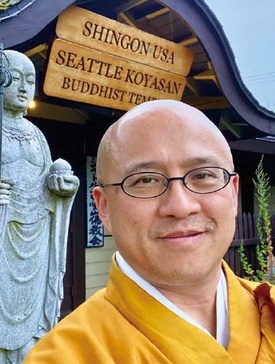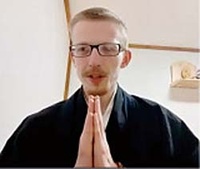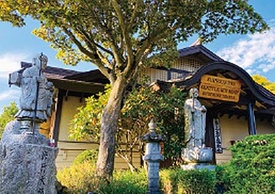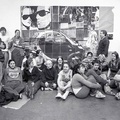Seattle Koyasan is a Shingon Buddhist temple founded in 1949. Taijo Imanaka has served as the temple's chief priest for a total of 14 years, and he is constantly asking himself how Buddhism can be useful to people in America, and continues to take on new challenges. We spoke to him about how he became a monk and came to America as a missionary, and the true value of Buddhism.
* * * * *
I want to encourage people living today through Buddhism.
This year marks 1250 years since the birth of Kobo Daishi Kukai, who founded Mount Koya, the head temple of Esoteric Shingon Buddhism. Shortly after the war, Mount Koya was built by first-generation Japanese Americans in a place overlooking Seattle's International District. The head priest there is Taijo Imanaka.
The attendees are incredibly diverse. Due to the pandemic, the service began streaming live in English in 2020, and now has participants from all over the world, including Canada, the UK, Australia, Luxembourg, Brazil, and Sweden.
"For Americans, Buddhism is still perceived as something only a handful of people have. They see and hear books and famous sayings and think it's somehow wonderful. But Buddhism is essentially like a sturdy walking stick that you can use to face and overcome human suffering. My role is to help close the gap between Buddhism and people."
Not fancy tableware for special occasions, but tableware for everyday use that you naturally reach for. This is the kind of Buddhism Tajo aims for. In order to make Buddhism feel more familiar to people, he also focuses on meditating four times a week in addition to Sunday worship. Tajo explains that meditation is a journey in which you observe all living things with the eyes of your mind, and discover that they are no different from you. "In Kukai's words, 'To observe all living beings that have no connection to the Dharma realm is to view them as if they were your own self.' What he means is that if you look carefully around the world, you will find that even among people you don't know, you will find a soft, delicate heart just like mine."
In his sermons, he often touches on current world events, such as the big earthquake in Turkey and the mass shooting at an elementary school in the United States. When Russia began its invasion of Ukraine, he chanted mantras and prayed together. "The core of Shingon Esoteric Buddhism is worship. The driving force behind this is worry, that is, worrying about someone's sadness or pain."
At the end of the session, someone turned on their camera and said, "I'm participating from Ukraine." My Zoom screen name is Wabo. In kanji, it is written as "和防". It means to protect peace and prevent Russian invasion. I participated in the meditation every week for about a month.
Worried about his safety, Tajo invited him for a one-on-one conversation. His real name is Yan, a 26-year-old young man who lives in Lutsk, western Ukraine. Yan explains that he started a Zen meditation club in a town with only three Buddhists. Tajo immediately contacted an acquaintance at Mount Koya in Japan, who donated a work uniform. He also says that he was able to receive a steady stream of donations of green tea, sweets, incense, and other items from local stores, which he was able to deliver to Lutsk. "I just arranged for this connection," says Tajo, his expression ever-soft.
The path to becoming a monk
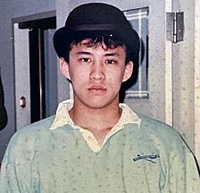
He grew up in an ordinary Japanese family. Although there was a small Buddhist altar at home, Taijo said he was a "lazy Buddhist" who only had a monk come to see him during Obon and Higan. When he became a high school student, Taijo began to think seriously about death, and was overwhelmed by the fact that "I will surely die too," and he continued to have dreams about dying every night. He couldn't concentrate on studying for his entrance exams, saying, "A good school or a good company is nothing compared to the big deal of having to die." He spent his days reading every book he could find, hoping to find an escape route from death. During this time, he came across Ryotaro Shiba's historical novel "The Landscape of Kukai." He resonated with Kukai's way of looking at the universe and life, and as he continued to read, his heart, which had been frozen by the fear of death, began to melt.
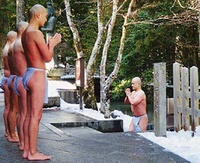
After entering university and majoring in Oriental art, he resolved to become a Buddhist monk. After graduating, he endured arduous training at Mount Koya, and finally achieved his dream of becoming a monk. As a new monk, Tajo's role was to visit parishioners. In an area where it is still customary to call monks on the monthly anniversaries of the deceased's death, Tajo visited more than a dozen houses every day and recited sutras.
However, Taijo, who is only 23 years old, has no chance to have a lively conversation with the parishioners. In the first place, he could not find any value in his existence, wondering how the shallow sutras he recited as a novice could reach the souls of those who died decades ago and how they could be of any use.
"Just as Buddhism encouraged me during my adolescence, I want to encourage those who are suffering now because I am alive," Taijo said, but he once again found himself lost in the darkness with no clear future.
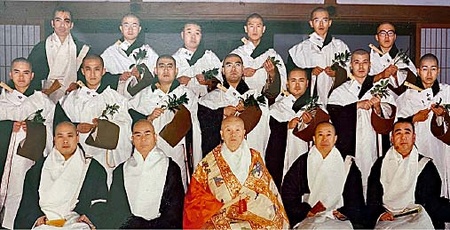
One day, he was ordered to perform the Buddhist sutra at the bedside of a 24-year-old young man who had died in a motorcycle accident. A Buddhist sutra is a ritual in which sutras are recited at the bedside of a corpse to calm the soul. In front of the mother who was in a state of confusion after losing her son, Taijo's tension reached an extreme and his voice trembled as he recited the sutra. After the funeral, the seventh day after death, and the 49th day, he never missed a monthly visit to the temple, and eventually, around the third anniversary of her death, the mother said, "I'm glad you came," and confessed that she had been thinking of following her son and dying.
"Every month, they came to recite sutras, and sometimes they cried with me. Thanks to them, I didn't die," he said. It was the first time that Taijo felt the value of his existence as a Buddhist monk.
What emerged beyond the suffering
As Taijo's work as a monk became more and more rewarding, a new doubt began to arise in his mind: "Can Buddhism, which is a source of spiritual support for the Japanese people, really be accepted worldwide?"
As long as I'm in Japan, I can't cross the barriers of sects. The only people I come into contact with are parishioners of the same sect. "The teachings of Buddha and the wisdom of Kukai should be universal." It's only natural that Hanshin Tigers players are popular at Koshien Stadium. I wanted to test my abilities as a monk by stepping out of that comfort zone and going to a land of different cultures and religions to see if the Buddhism I create is needed and can help those in distress.
There are 14 Koyasan Shingon temples in Hawaii and five on the American mainland. Taijo immediately applied to go to the United States. At first, the head priest was reluctant, but he sent him off with a smile. His destination was Seattle. He was supposed to leave for California, but due to various circumstances, his plans were suddenly changed.
However, he was struggling to adapt to the unique environment and customs of a Japanese temple in the United States, and was unable to achieve the results he had hoped for. After five years, his parents fell ill and he returned to Japan before his goal was achieved. When he returned to Seattle in 2014, the core members of the second generation of Japanese-Americans were approaching their late 80s, and there were no third generation members. The temple was facing a crisis of survival.
"How can we make this temple relevant even to people who have no connection to Buddhism?" Taijo pondered, and changed his approach.
"Let's try something new. Let's jump into society and increase our contact points with the world one by one." That's when we started exhibiting at Sakura Con and Dragon Fest . As we continued, a different view began to unfold.
At Sakura Con, they sell amulets and prayer beads. Word of mouth has spread and cosplayers dressed as anime and game characters line up. When asked why they want amulets, contrary to expectations, they all have serious reasons.
A teenage girl prays for her boyfriend, who is being abused by his parents, to be protected. A police officer engaged in dangerous work prays for his own life to be protected for the sake of his child. A young woman worries about her husband, a Marine, who won't be coming back from Afghanistan for another three years.
After Taijo prays with all his heart and soul for 10 minutes and puts his soul into the amulet, many people begin to shed tears.
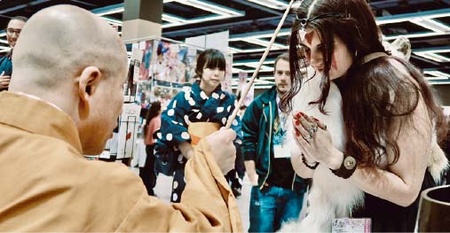
There was one scene he never forgot at Dragon Fest. A young mother with two children was visiting a booth. In the hustle and bustle of the festival, he looked up and saw that the mother had no nose. It was completely crushed. "I hope these children are protected from their father." When the woman said this with a slightly angry voice, Taijo realized that the woman in front of him was a victim of domestic violence.
As these experiences continued, Taijo eventually realized something: "These people probably had never had someone pray for them from the bottom of their hearts. Perhaps this is where we can connect people who have no connection to Buddhism."
Taijo's challenge continues. "The reason for the existence of monks is to help those who suffer because they are alive and who are at risk of drowning at any moment. Our temple is a field hospital for the soul. We will be there for them as long as they are suffering. Buddhism on the streets, I think."
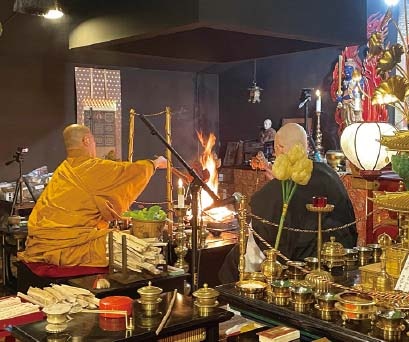
* * * * *
Imanaka Taijo: Born in Osaka in 1968. After majoring in Oriental Art at Keio University, he became a monk at Rengejo-in Temple in Koyasan in 1992. In 2006, he was appointed as a missionary at Seattle Koyasan. In 2011, he returned to Japan and educated monks as a dormitory supervisor at Entsu-Ryūji Temple before being assigned to the International Affairs Bureau of the newly established Kongōbu-ji Temple. He returned to Seattle Koyasan in 2014 and continues to serve as the chief priest there today. He is also an active advisor to the Center for Interreligious Education and Exploration (CEIE), which was established with the aim of promoting interreligious understanding and dialogue. He has one daughter with his American wife.
*This article is reprinted from " SoySouce " (August 9, 2023).
© 2023 Keiko Miyako Schlegel


